The Sharp GR8 is a television created primarily for those who expect a maximally smooth image. It is somewhat of a successor to the FQ8 model, and it's clear that the manufacturer has strongly focused on the dynamics of motion. 144 Hz makes a difference – and not just in games. Sports broadcasts can also look stunning, without those annoying blurring or "stutters" that can detract from the enjoyment of watching. In terms of image quality, Sharp has opted for a VA panel. While there is no local dimming, one can still count on pleasant contrast. Additionally, there's Dolby Vision, which gives evening movie screenings depth – even if the television does not reach the brightness promised by the manufacturer. It must be said that when the lights in the room are dimmed, the overall presentation is truly pleasing to the eye. One of the biggest advantages of the GR8 is Google TV. We have access to a full range of applications, voice search in Polish, and a simple, intuitive interface. This means we are not limited to the standard functions of the television, as there is always the possibility to install additional programs and customize the system to our own needs. Of course, a few things could have been refined. The declared HDR brightness is higher on paper than in reality, which may leave the most demanding cinema enthusiasts wanting more. Additionally, a few useful features known from other models are missing: there is no USB recording or PiP function, and Apple device owners will be disappointed by the lack of AirPlay. Nevertheless, this is a television primarily aimed at those who value smooth images and high refresh rates. If we primarily care about dynamic gameplay and good support for games, and in the evenings we want to quietly watch a movie with pleasant image quality, the Sharp GR8 should meet those expectations.
- Matching (Score)
- Our verdict
- TV appearance
- Where to buy
- Contrast and black detail
- HDR effect quality
- Factory color reproduction
- Color reproduction after calibration
- Smoothness of tonal transitions
- Image scaling and smoothness of tonal transitions
- Blur and motion smoothness
- Console compatibility and gaming features
- Input lag
- Compatibility with PC
- Viewing angles
- TV efficiency during daytime
- Details about the matrix
- TV features
- Apps
- Playing files from USB
- Sound
Sharp GR8 vs SAMSUNG QN80F
Direct compare
Check the best price offer:
SAMSUNG QN80FGR8765E / GR8465E / GR8265E
QN80F

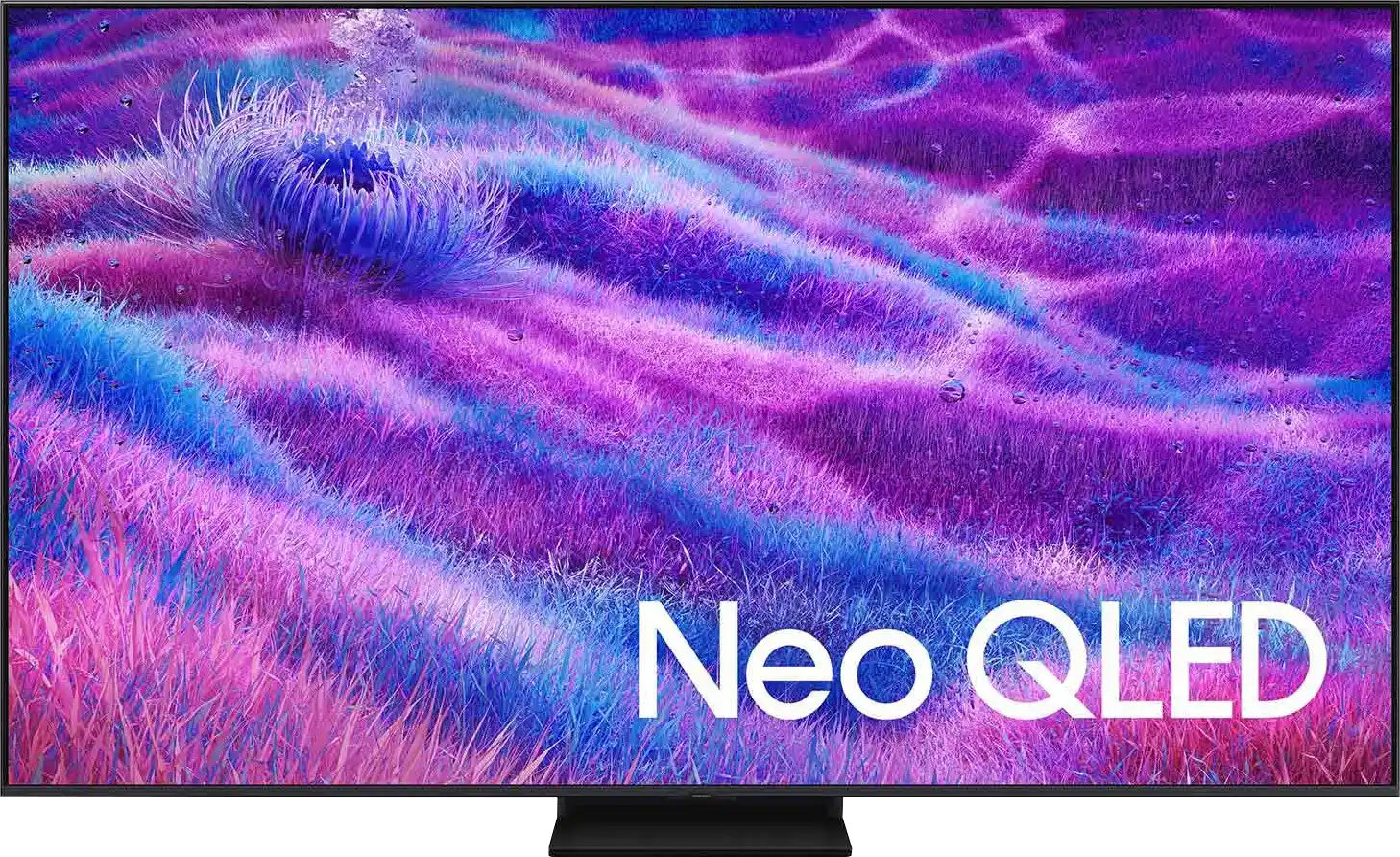
Panel type: LCD VA
Resolution: 3840x2160
System: Google TV
Model year: 2024
Complete the survey to find out the result

Panel type: LCD VA
Resolution: 3840x2160
System: Tizen
Model year: 2025
Complete the survey to find out the result

Overall rating
6.4
7.3
Movies and series in UHD quality
6.2
6.9
Classic TV, YouTube
6.1
6.8
Sports broadcasts (TV and apps)
6.4
6.7
Gaming on console
7.8
8.5
TV as a computer monitor
4.0
8.8
Watching in bright light
4.5
6.6
Utility functions
6.0
7.7
Apps
9.6
8.7
Sound quality
7.0
6.7
Complete the survey to find out what fits your preferences
Advantages
VA matrix with decent contrast
144 Hz refresh rate and two HDMI 2.1 ports – a great option for gamers
Support for VRR and ALLM, low input lag
Supports Dolby Vision
Google TV with a rich selection of apps, voice search in Polish, and an intuitive interface
Decent sound
Nice black and contrast - VA matrix combined with MINI-LED backlighting.
Great brightness - up to 1000 nits in HDR
Fast and responsive matrix - 144 Hz
Rich support for gamers - 4xHDMI 2.1, VRR, ALLM, GameBar, Game Motion Plus
Very good usability in daylight
Advanced Tizen operating system
Simple operation
PiP function
Disadvantages
Brightness in HDR lower than claimed by the manufacturer (about 360 nits instead of 500)
In PC mode, it does not support chroma 4:4:4 - text and fonts are less readable because of this
No USB recording and PiP function
Lack of support for AirPlay - Apple device owners may feel unsatisfied
No support for DTS format – limitation when connecting home theater
No USB recording function
Relatively small number of dimming zones
Issues with HGiG function (for gamers) – update removed this option*
Our verdict
QN80F is the first in the history of Samsung's "eighty" series to feature Mini LED backlighting. And it does this really well. Although the number of dimming zones is not overwhelming, the black level is solid, and combined with high brightness, it allows for a very decent picture in HDR content. Additionally, there's a 144 Hz panel that provides excellent motion smoothness, and the set of features for gamers – VRR, ALLM, Game Motion Plus – makes the QN80F a model practically designed for those playing on console or PC. The television operates quickly and responsively, and the Tizen system runs like lightning – whether you're searching for apps or switching sources. Is there anything to criticize? Of course, as always – there are shortcomings in the system (like recording to USB), there’s no DTS support, and Mini LED is not without its limitations. But the QN80F is a great everyday television – versatile, well-thought-out, and... with significant price potential. Looking at the history of this series, we can expect this "eighty" to shake things up once it hits the first reasonable promotions. And it could be virtually unbeatable at its price – especially if Samsung improves the minor teething issues.
TV appearance




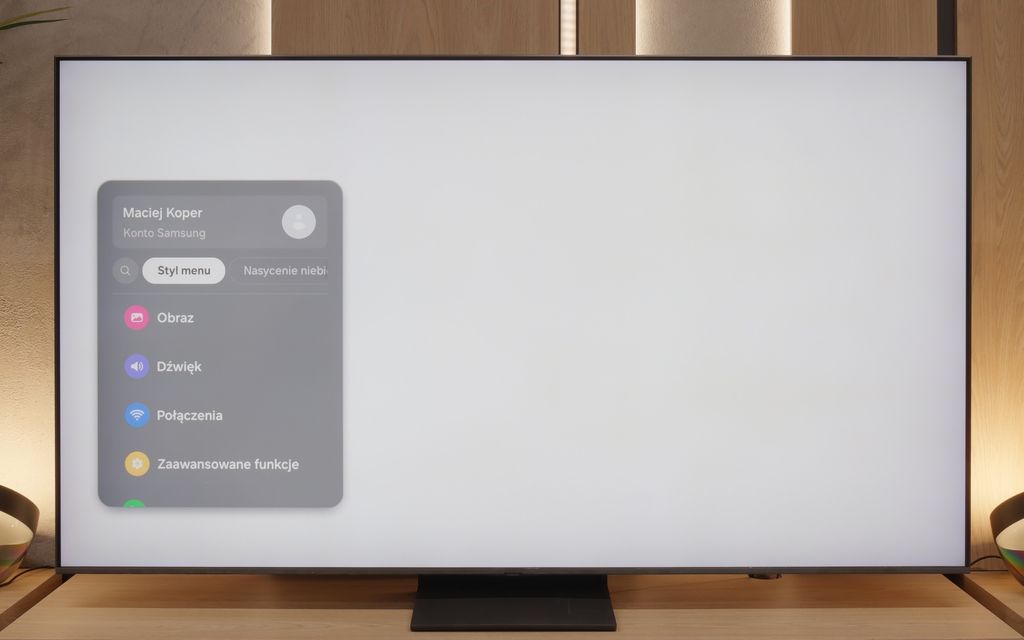
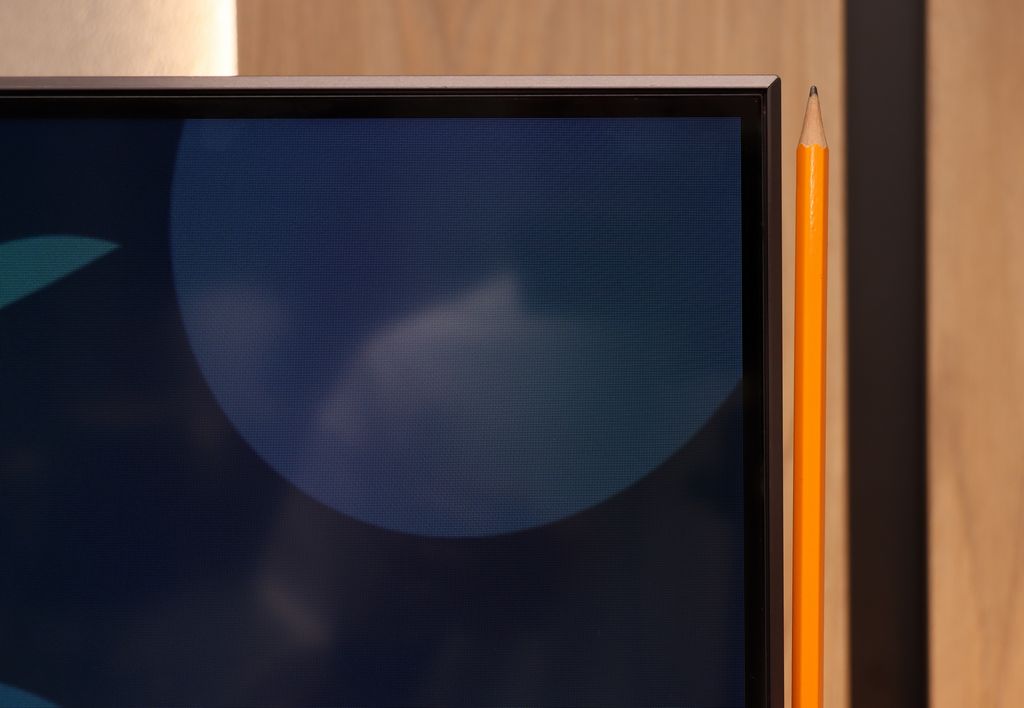
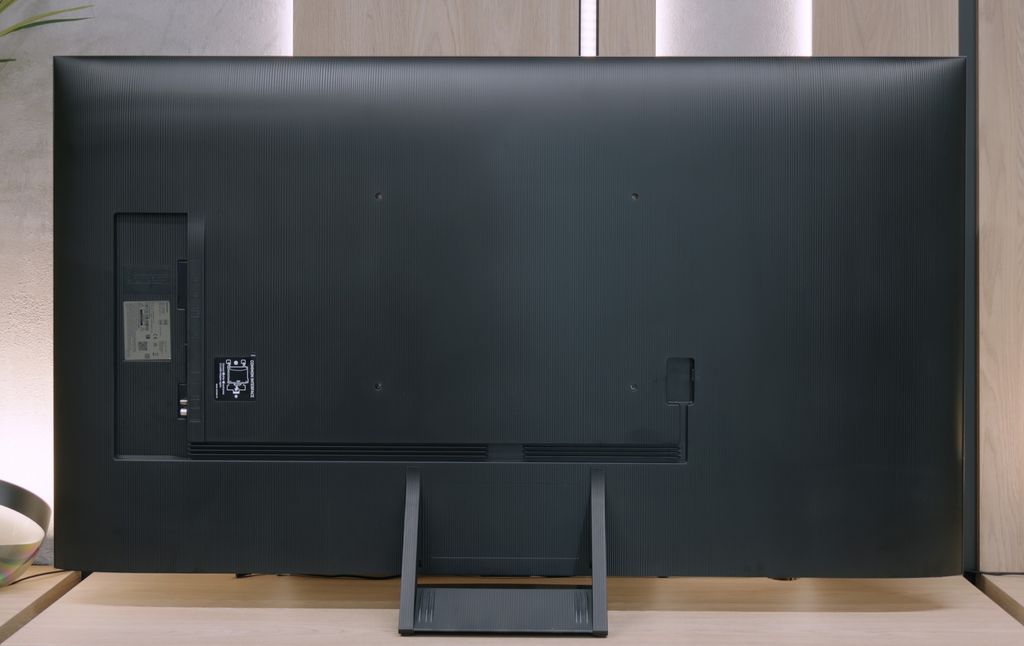
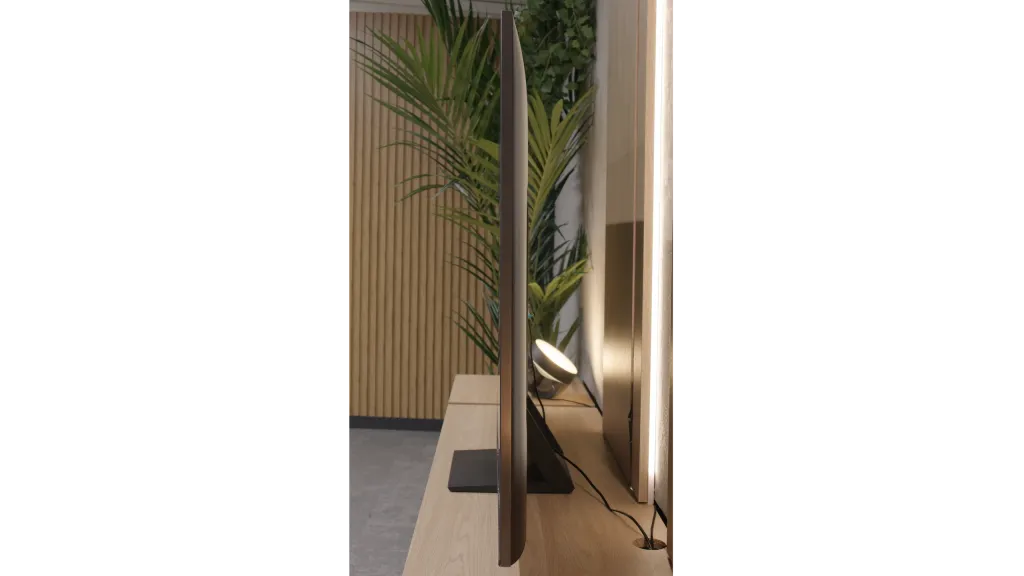
Contrast and black detail
5.9/10
6.8/10
Local dimming function: No
Local dimming function: Yes, number of zones: 88 (8 x 11)
Contrast:

Result
5,300:1

Result
5,800:1

Result
6,600:1

Result
5,650:1

Result
4,700:1

Result
34,100:1

Result
8,200:1

Result
32,500:1

Result
4,550:1

Result
3,800:1
Halo effect and black detail visibility:

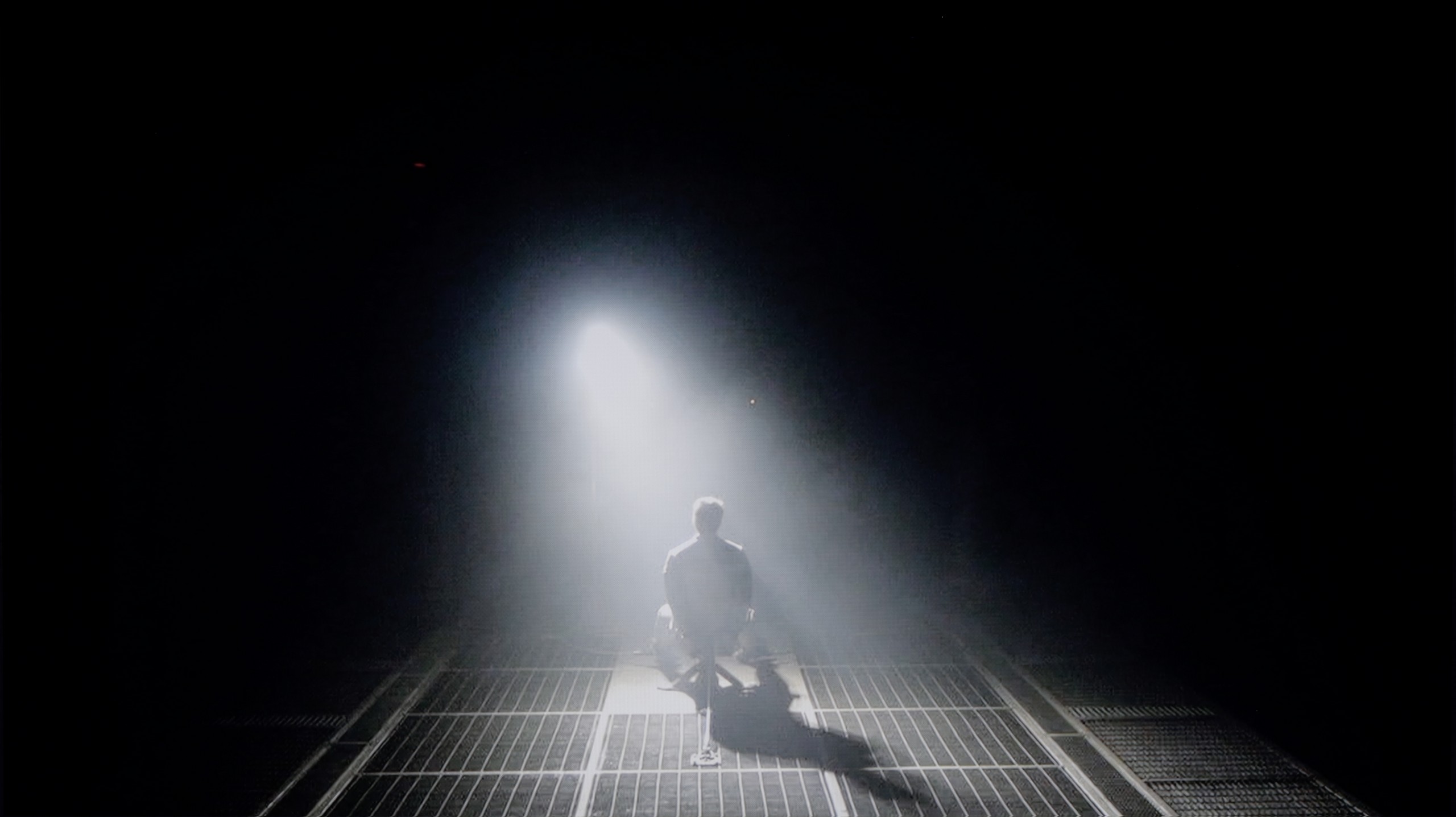
The Sharp GR8 utilizes a VA panel that can provide quite decent contrast. In the tested film scenes, for example in “Arrival”, the television demonstrated that it can achieve really good results. A contrast ratio of 6600:1 is a result that can be considered solid in this price segment. However, it should be mentioned that the television is not equipped with local dimming technology. This is quite obvious, considering the class of the equipment. Nonetheless, the Sharp GR8 handles the separation of bright and dark elements well, which definitely deserves recognition. It is worth noting that televisions without local dimming have their limitations. In very dark conditions, such as during a screening in a completely dark room, blacks can take on shades of navy blue instead of appearing deep and pitch black. In general, the Sharp GR8 offers quite solid contrast that should satisfy most users.
QN80F is a representative of the Neo QLED series, which means it's a television with Mini LED backlighting. Unlike its cheaper cousin, the QN70F model, here the diodes are placed directly behind the panel (rather than at the edges), which gives a solid advantage in contrast control right from the start. In the 65-inch variant we tested, we counted 88 local dimming zones – a result that may not be particularly impressive, but as it turned out, sufficient to achieve quite decent results.
In tests based on scenes from movies like Oblivion and The Meg, the QN80F performed well – blacks were deep, and the overall image consistency was eye-catching. However, in more demanding moments (e.g., scenes with a lot of bright details on a dark background), a halo effect appeared. This is where the limitation of the number of zones shows – bright elements could bleed into each other, and some details in dark areas lost sharpness and contrast. In one of the helicopter scenes (The Meg), we even noticed a slight flicker in brightness, as if the television was trying its best to maintain visibility of details at the expense of black depth.
However, these are not problems exclusive to this model – the halo effect or contrast drops in very complex scenes are something most Mini LED televisions struggle with, even the more expensive ones. In its class, the QN80F still performs positively and offers clearly better contrast than the QN70F model with edge lighting. For most users, this will be a level more than sufficient – though not ideal.
HDR effect quality
4.8/10
5.8/10
Luminance measurements in HDR:

Result
305 nit

Result
332 nit

Result
369 nit

Result
365 nit

Result
367 nit

Result
799 nit

Result
533 nit

Result
717 nit

Result
245 nit

Result
656 nit
Scene from the movie “Pan” (about 2800 nits)


Scene from the movie “Billy Lynn” (about 1100 nits)


Static HDR10


Dynamic: Dolby Vision
Dynamic: HDR10+


HDR luminance chart:
SAMSUNG QN80F
HDR luminance
Sharp GR8
HDR luminance
Sharp GR8 boasts "very high brightness" at a level of 500 nits in its promotional materials. Unfortunately, our tests showed that the reality is somewhat different – the average luminance value we managed to achieve was around 360 nits. This is rather an average result, especially in the context of the manufacturer's claims. Such brightness does not allow for a full enjoyment of HDR effects. The image is somewhat sharper than in standard SDR, but it is difficult to speak of true juiciness and depth in bright elements. However, the coverage of the DCI-P3 color palette at 95% deserves praise. This is the result of applying an additional PFS coating, known from QLED technology. As a result, colors are vivid and have a pleasant, natural tint, which partially compensates for the deficiencies in brightness.
QN80F is quite a bright screen – in synthetic tests, it achieved nearly 1000 nits, which allows for reasonable expectations with HDR content. And indeed, in many scenes, the television truly shines. Sequences with a lot of light – such as shots from the movie Life of Pi or wide, bright surfaces in The Meg – look spectacular. Brightness maintains around 700 nits, which provides a solid effect, sufficient to feel the true "HDR magic." Unfortunately, not every scene looks that good. In materials with small, bright details on a dark background, like in Sicario 2, the television has problems – it can dim certain elements significantly, sometimes to the point where they disappear from the image. This is the result of a limited number of dimming zones, which forces the device to make compromises: either stick to inky blacks or sacrifice some details. QN80F usually chooses the former. As a consolation, it has quite decent coverage of a wide color gamut – DCI-P3 at 93%. This is not the highest score on the market, but it is more than enough for most content on streaming platforms.
Factory color reproduction
5.4/10
6/10


Factory Mode
After calibration


Factory Mode
After calibration
At the outset, it is worth noting that color reproduction tests are always conducted in the best factory picture mode. In the case of the Sharp GR8, this is the "Film" mode. As for the white balance, which is a characteristic that affects how we perceive colors on the screen, in SDR mode, the strong dominance of blue immediately stands out. This results in an unnatural cooling of the image—blue elements take on a purple hue, and skin tones acquire a pink glow, which we can see in the comparative photo from the movie STAR WARS. During the Color Checker test, it was clearly visible how the color samples deviated from the reference values, confirming significant errors in color reproduction. Gamma was not perfect either—it caused excessive brightening of the entire image, causing the scene to lose depth and proper tonal transitions.
In 4K HDR mode, the situation looks much better. The dominance of blue is much less noticeable, although there are minor issues with the combination of red and blue. This makes some shades look somewhat unnatural. The EOTF curve, responsible for the brightness of the image in 4K HDR content, showed another problem—the television tends to excessively darken the image across the entire screen.
In summary, the "Film" mode on the Sharp GR8 would require some adjustments to fully utilize the potential of this television. Fortunately, we addressed this and proceeded to calibration.
We always test televisions in the best available factory mode – for the Samsung QN80F, this is the Filmmaker mode, and indeed, it offers the settings closest to the creators' intentions. However, this doesn't mean that everything looks perfect. In SDR content, the biggest issue turned out to be an unbalanced white balance – slight deficiencies in green and a noticeable excess of red led to noticeable color errors, and one could almost say there was a pinkish tint to the screen. This was clearly visible in the color checker test, where colors would "escape" their target fields – to the extent that a sensitive viewer's eye could catch it even without the help of a meter.
In HDR content, the white balance was much better, but another problem emerged – brightness management. The EOTF curve caused an overly bright image most of the time, which could affect the perception of contrast and made the screen slightly "flicker" during dynamic light changes. We have already discussed this in the paragraphs about black and HDR. Fortunately, Samsung leaves the user with plenty of options. The QN80F offers a rich set of calibration options, including a 20-point white balance – that's why we decided to check what this television is really capable of after proper calibration.
Color reproduction after calibration
8/10
8.3/10




Sharp GR8 is one of those televisions that really gains a second life after proper calibration. Both in HD and 4K content, the white balance performs very well, especially considering the price segment of this model. The image becomes much closer to what the director wanted to show – colors look natural, and skin tones acquire the appropriate depth and warmth. The brightness characteristics also leave a very positive impression. Both gamma and the EOTF curve show really solid values. Although minor imperfections can be noticed, they are subtle enough that it's hard to see them during everyday viewing. In summary, calibration makes the Sharp GR8 show its best side, offering an image that is not only pleasant to the eye but also faithfully conveys the creators' intentions.
After conducting a thorough calibration, it was possible to bring most image parameters to a really good level. The white balance in both SDR and HDR appears nearly perfect – the image is natural, neutral, and free of the previously noticeable reddening. The colors have gained depth, and the overall visual reception has become more pleasant and cohesive. It was also possible to partially master brightness management, which in the factory version could be problematic. The EOTF chart shows that the television performs significantly better with brightness after calibration – there's no longer excessive dimming of certain elements. In films, it can still be observed that the QN80F has a tendency to slightly brighten the smallest, bright details – this is already a result of the device's construction and the limited number of dimming zones. In short: not everything can be overcome, but what could be improved has been addressed. After calibration, the QN80F makes a really good impression; it simply looks more mature and professional.
Smoothness of tonal transitions
8/10
9/10





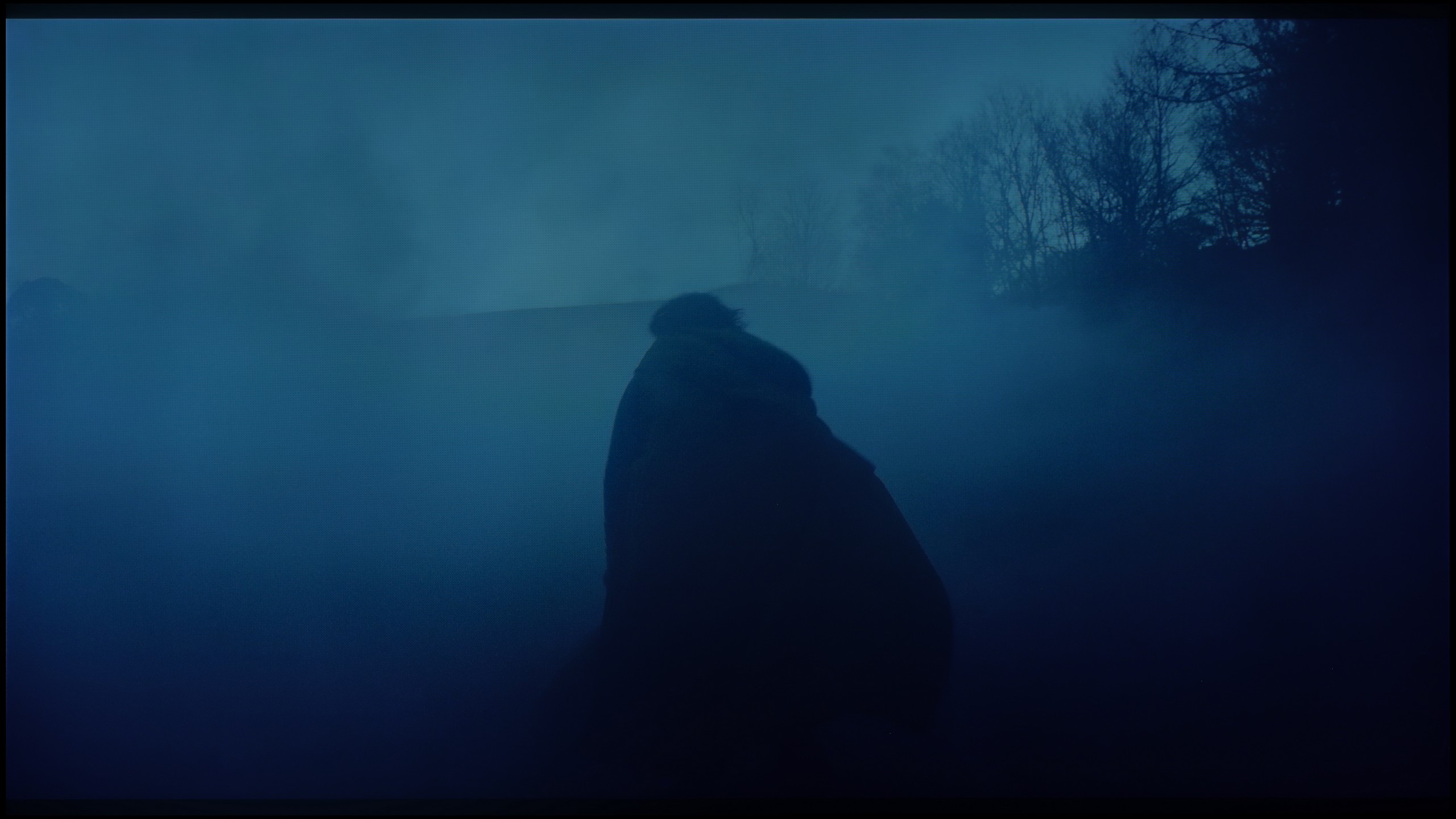

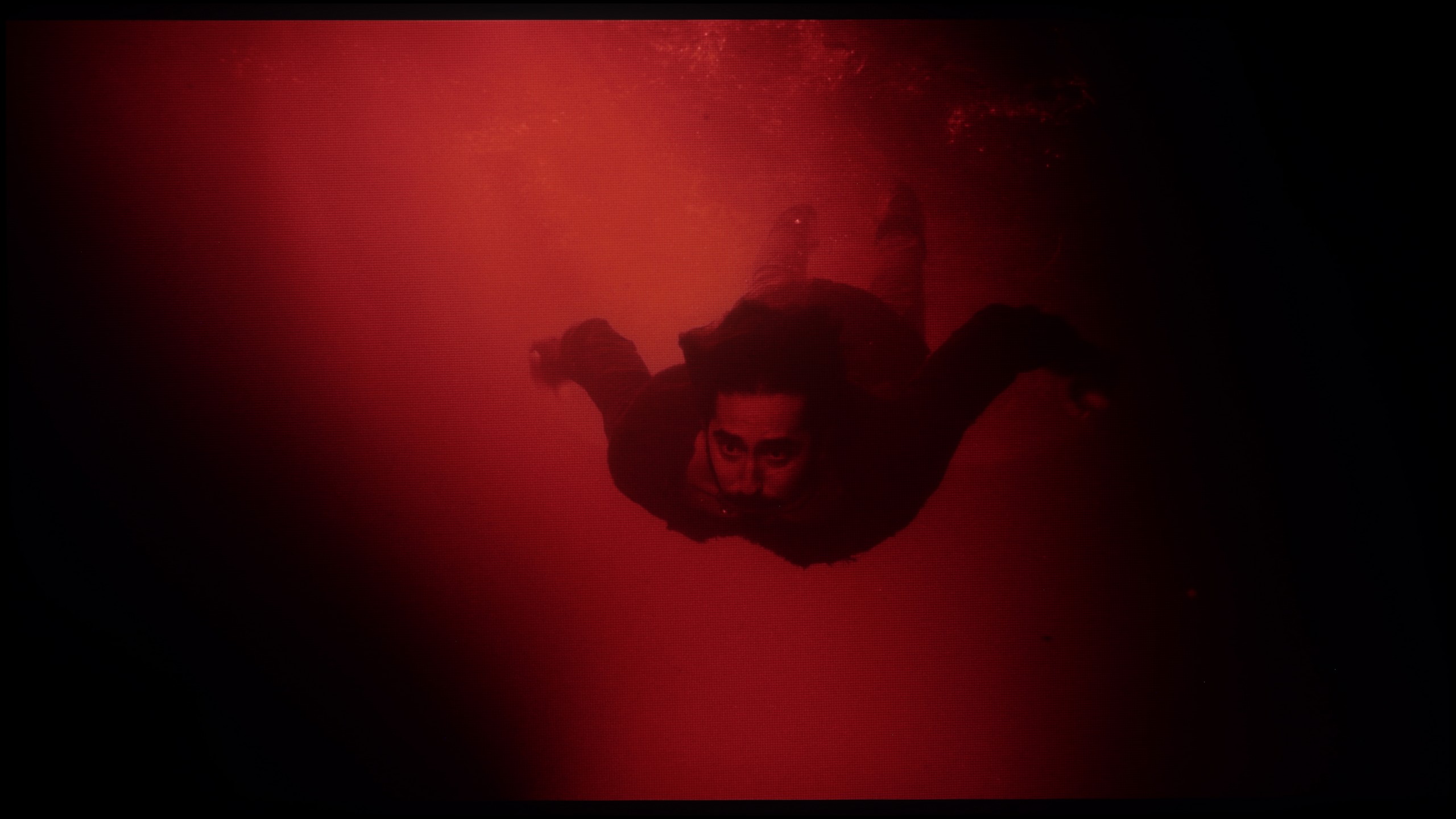




When it comes to the fluidity of tonal transitions in high-quality materials such as 4K, the Sharp GR8 performs really well. Color gradients are smooth, and the transitions between shades are natural and free of visible artifacts. The TV has no problems reproducing subtle differences in colors, even in demanding scenes. Only the most discerning users, who examine the image closely, may notice minor imperfections in the darkest shades. For most viewers, the quality of tonal transitions in the Sharp GR8 will be more than satisfactory and will not negatively affect the perception of the image.
In this regard, the QN80F really delivers. The transitions between colors are smooth, nothing is choppy, and there are no annoying bands in the sky or strange blotches in the shadows. Movie scenes in darker tones performed particularly well – and that's where most televisions start to struggle. If one really looks for it, slight banding can be seen in the brightest areas, but that's really just nitpicking. In everyday viewing, no one should have a problem with this. To put it simply: the tonal transitions are so good that you can forget about them – and just enjoy the movie.
Image scaling and smoothness of tonal transitions
5.5/10
7/10
Smooth transition function

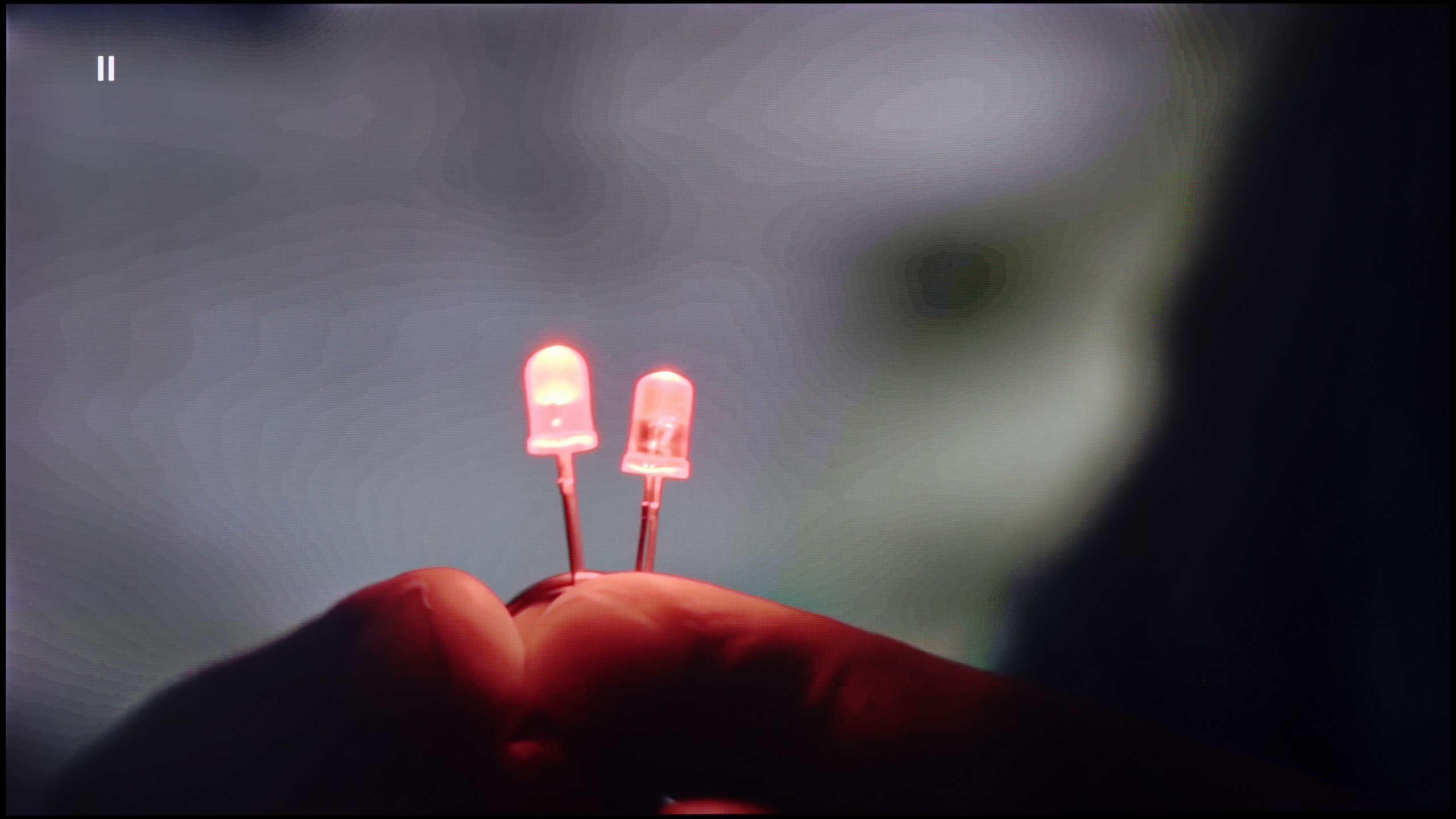
Image without overscan on the SD signal


The Sharp GR8 is equipped with the "10-bit color reproduction" feature, which theoretically should improve the smoothness of tonal transitions. In practice... well, the effect is surprising, but not in a very positive way. Even at the highest settings, it's hard to notice any impact on the actual tonal transitions. Instead, the function surprisingly smooths out things it shouldn't – walls, shirts, or other flat surfaces look almost like they have been steam-pressed. In the test, we had to note that there is simply no actual impact on tonal transitions.
When it comes to image scaling, the Sharp GR8 performs significantly better here. The television is capable of giving the image a plastic, smooth characteristic, making even lower resolution content look quite good. Of course, with more demanding details, such as thin tree branches in the background, you can see slight jaggedness, but this is not something that would significantly affect viewing comfort.
If, while watching lower-quality materials – for example from YouTube – we notice strange color transitions or unwanted artifacts, it’s worth checking the settings and enabling the noise reduction function. In our opinion, the best setting is at the "medium" level – it effectively smooths out problematic color transitions while not excessively blurring the entire image. However, one must know this: this option tends to remove film grain. If someone cares about preserving this effect (e.g., in older films), it’s better to just turn it off – regardless of the level, the grain always disappears.
When it comes to scaling resolution (i.e., the so-called upscaling), Samsung – as always – performs very well in this area. The QN80F may not compare to the top models worth several thousand, but for its price class, it really performs impressively. Very low-quality materials (e.g., from SD television or older video files) are noticeably improved and look surprisingly decent. The only noticeable drawback is the typical Samsung issue with overscan – that is, slightly cropping the edges of the image at very low resolutions, e.g., 576p.
Blur and motion smoothness
7.4/10
7.5/10

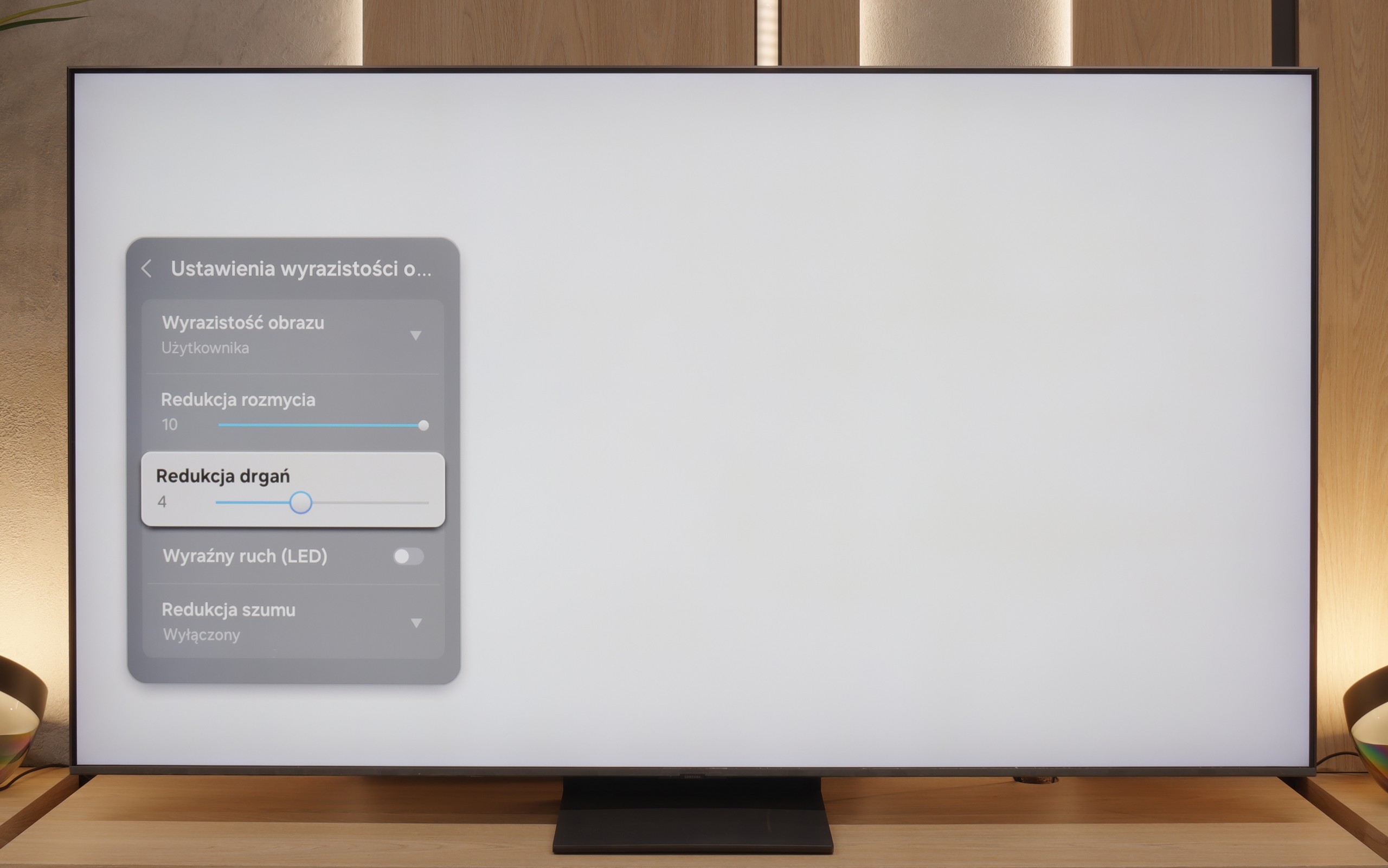
Blur (native resolution, maximum refresh rate):






Blur (BFI function enabled):
Image flickers in this mode



This is where the Sharp GR8 has the chance to stand out against the competition in its price segment. The TV is equipped with a 144 Hz refresh rate panel, which is an impressive result, especially if we plan to use it for dynamic content such as action movies, sports broadcasts, or video games. Additionally, the manufacturer has included a motion smoothing feature, commonly referred to as a "smoothener." The user has three levels of adjustment available, allowing them to tailor the effect to their own preferences – from subtle smoothing to more aggressive intervention in motion fluidity. This is a nice addition, especially for those who mainly watch movies and value smooth, cinematic sequences without annoying stuttering or frame drops.
QN80F is truly a "fast" television. The applied panel offers a refresh rate of up to 144 Hz, which in practice means that the screen keeps up with the action – whether we're watching a movie, playing games, or browsing dynamic content on the internet. The image doesn't tear, it doesn't excessively blur, and everything simply looks smooth and pleasant to the eye. Of course, the manufacturer hasn't forgotten about movie fans – in the settings, we find an option for motion smoothness adjustment, allowing us to tailor the effect to our personal preferences. You can leave a more "cinematic" look (for those who enjoy a classic film vibe) or crank up the smoothness to a higher level for a theatrical smoothing effect. Importantly, the choice is ours. Watching movies and playing on the QN80F is simply a joy.
Console compatibility and gaming features
7.8/10
8.2/10
- ALLM
- VRR
- VRR range48 - 144Hz48 - 144Hz
- Dolby Vision Game Mode
- Correct implementation of HGIG
- 1080p@120Hz
- 1440p@120Hz
- 4K@120Hz
- Game bar

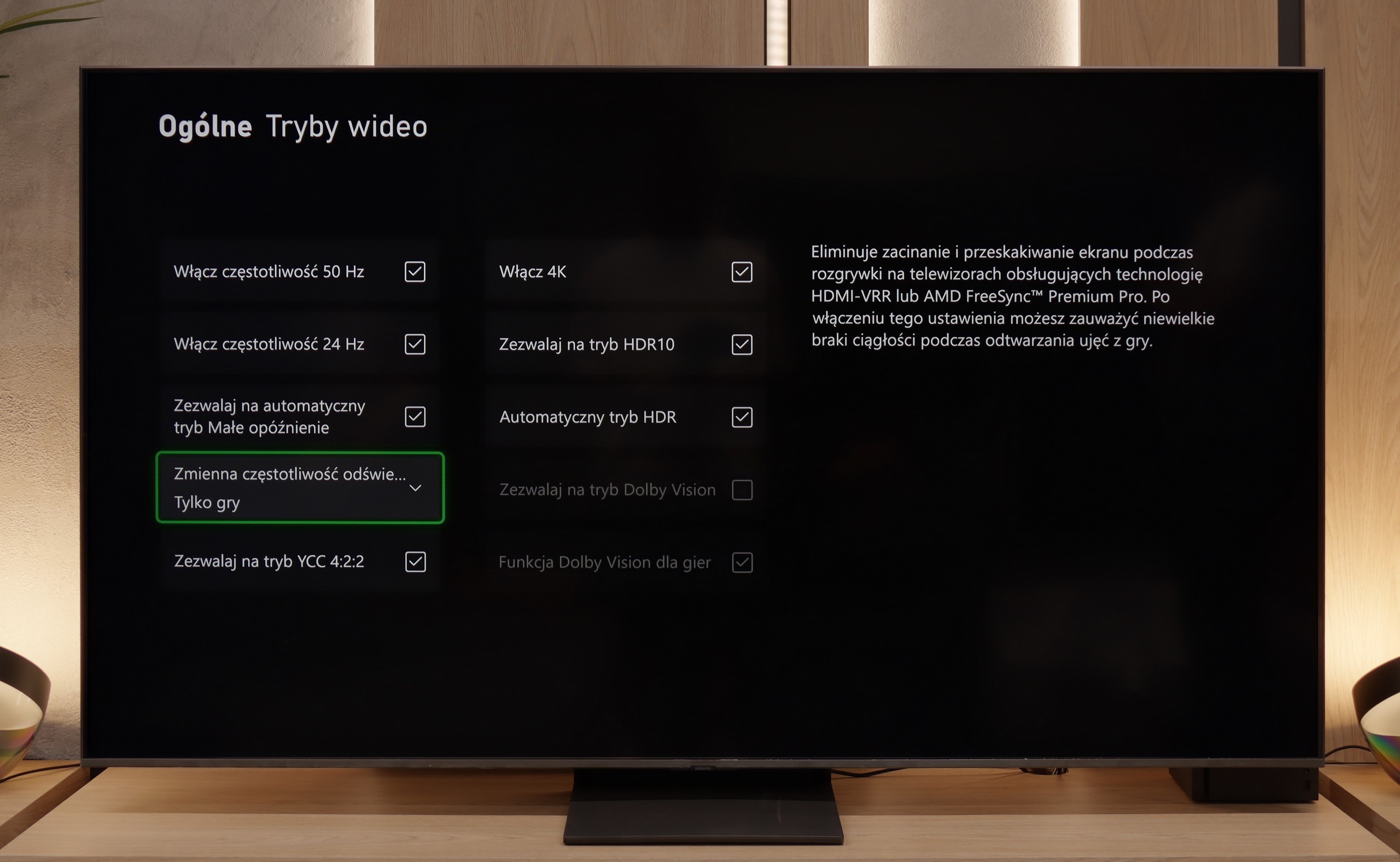

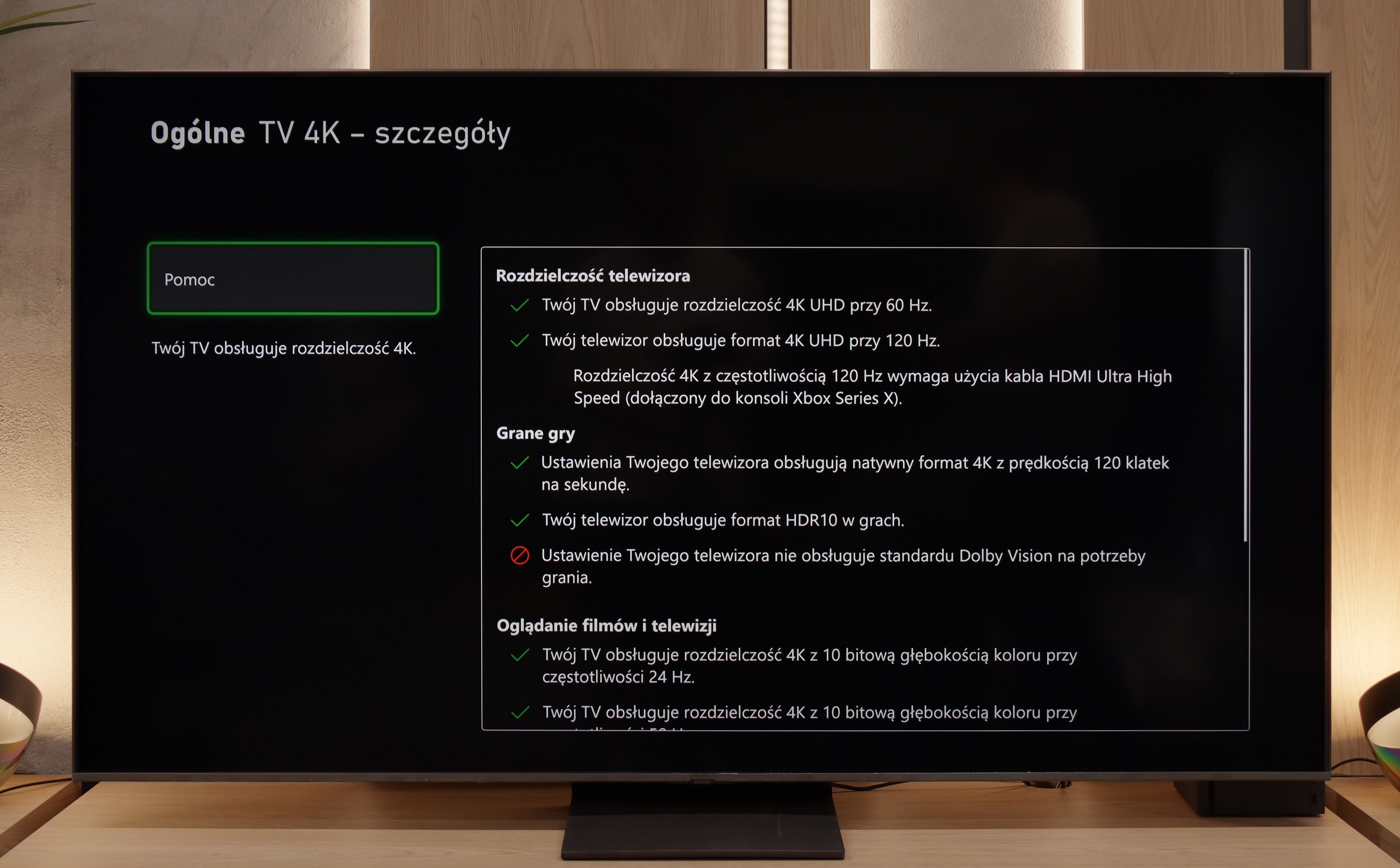

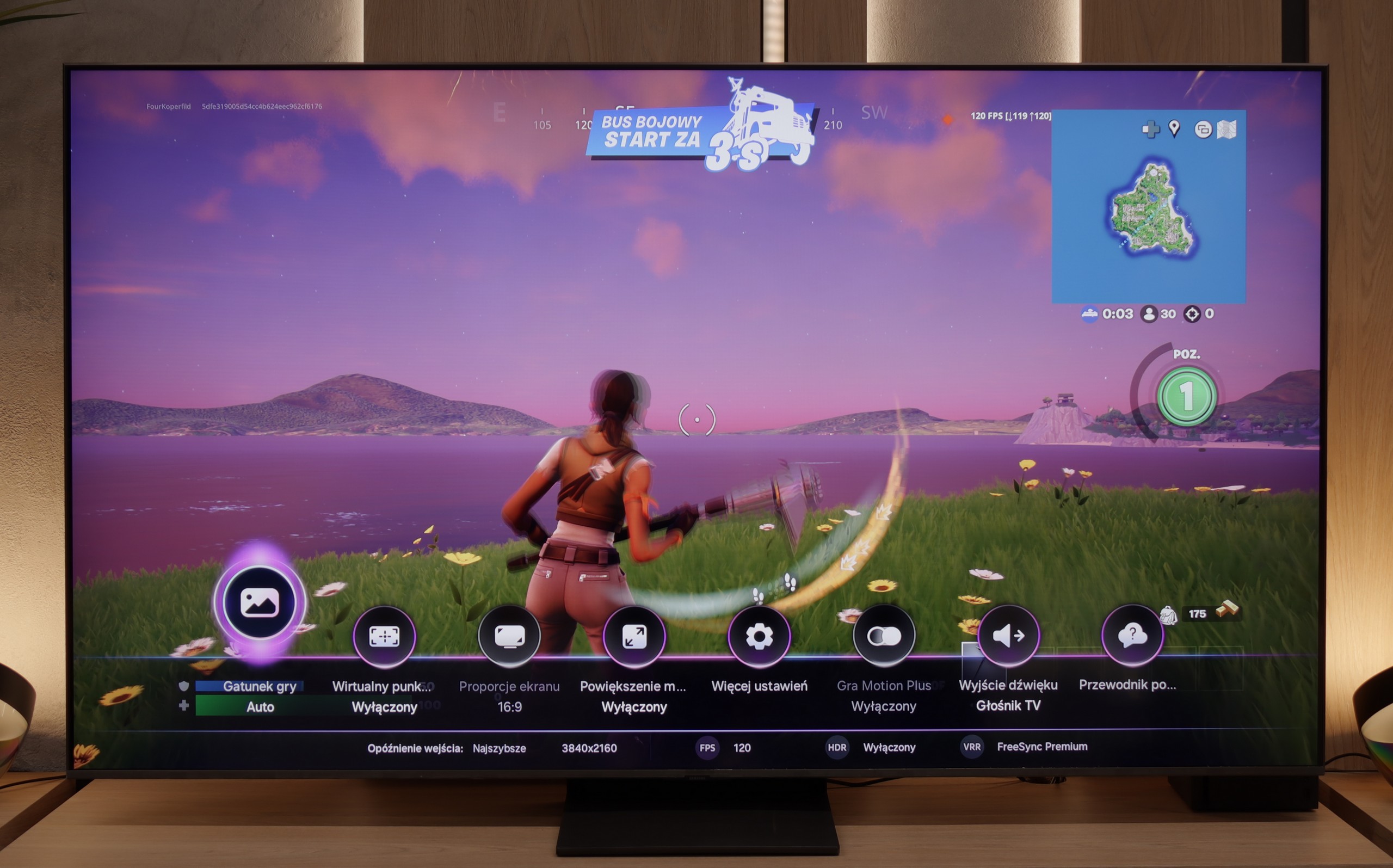

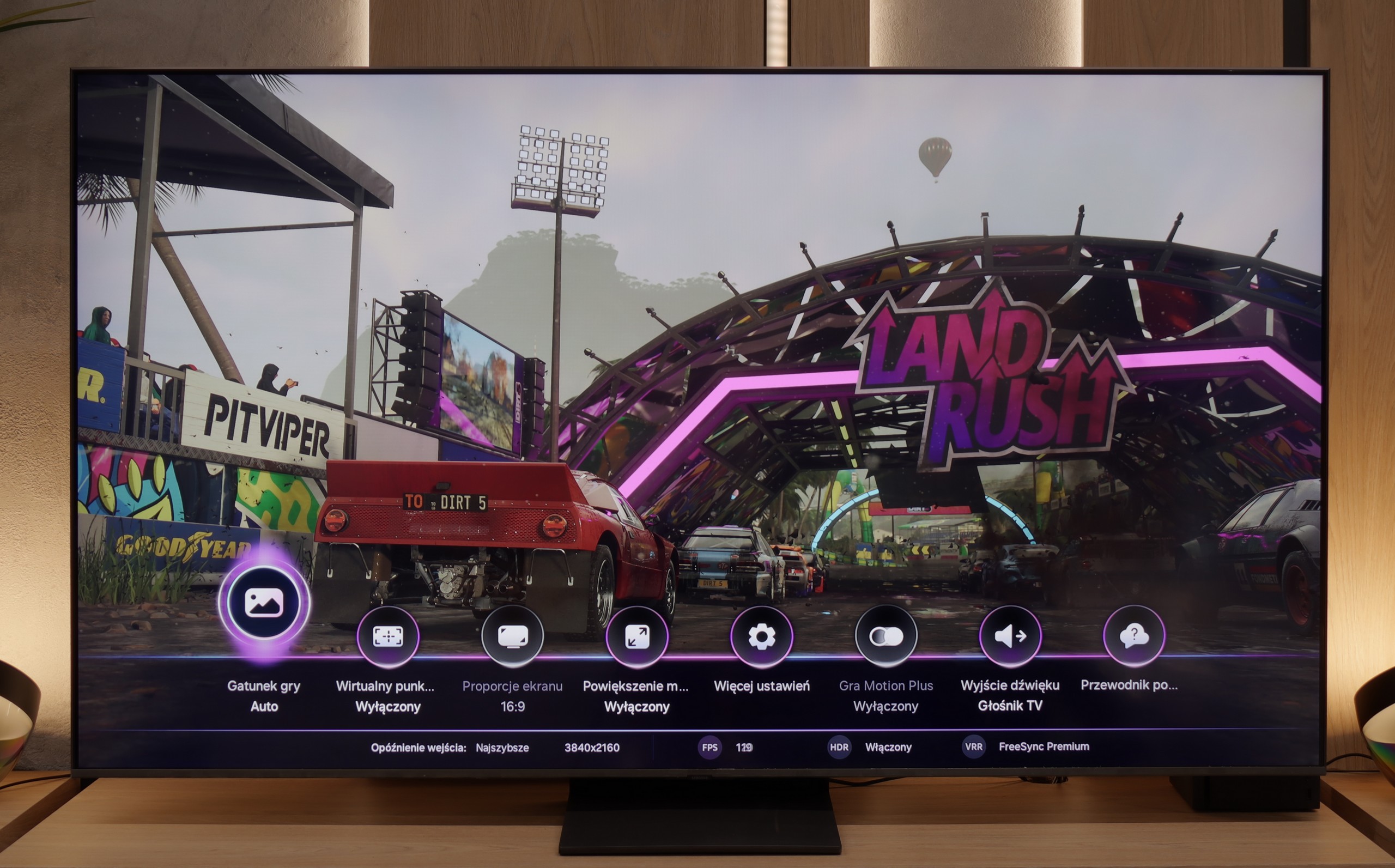
If a television has a 144 Hz display and two full HDMI 2.1 ports, it is clear that it has been designed with gamers in mind. The Sharp GR8 offers exactly that – high refresh rates and the right connections to maximize the performance of modern consoles and PCs. It also features ALLM, which automatically switches the television to low-latency mode, and VRR, which prevents screen tearing even in more demanding moments. In practice, everything works as it should, and it is hard to find any faults. However, there are some shortcomings. It lacks support for HGiG, which is a feature that better adjusts HDR for games, as well as a Game Bar that makes it easier to quickly adjust settings without leaving the game. Despite these downsides, the Sharp GR8 is a really solid option for gamers.
The Samsung QN80F is a TV that delivers on almost every front when it comes to gaming. We have a 144 Hz panel, four fully-fledged HDMI 2.1 ports, support for gamers in the form of variable refresh rate (VRR), automatic low latency mode (ALLM), and even one of the best-designed game bars on the market. The cherry on top is the motion smoother, which – uniquely in the world – works in games without significantly increasing input lag. Sounds like almost the perfect TV for gamers? And indeed, it is almost that.
As usual, Samsung does not support Dolby Vision in games, but that no longer surprises anyone. However, what is much more surprising is that... the HGIG feature has disappeared – that is, the system that allows the console (e.g., PlayStation 5 or Xbox Series X) to precisely match HDR tone mapping to the TV's capabilities. In the latest firmware update for the 2025 models, this option has simply vanished. It looks more like a bug than a deliberate move, but it must be honestly pointed out that as of the day of writing this review, the HGIG feature is simply not available.
And it is precisely because of this one deficiency that the QN80F goes from being almost the perfect gaming TV to a "nearly" perfect device. It's a shame – because everything else indicated that Samsung could set the bar very high once again in this generation.
Input lag
9.7/10
9.8/10
SDR
HDR
Dolby Vision
The Sharp GR8 performs really well in terms of latency. At a refresh rate of 120 Hz, the input lag is only 9 ms, and at 60 Hz - about 18 ms. These are practically imperceptible values even for the most demanding gamers, where every millisecond counts. Importantly, the Dolby Vision mode also works responsively, which is not at all standard in TVs in this price range. This is definitely a big plus for those who want to enjoy not only smoothness but also better HDR effects while gaming.
QN80F does not disappoint when it comes to response time. The input lag for 120 Hz content drops below 10 ms, which can be considered an almost ideal result – it’s hard to expect more in this class of TVs. Gaming is smooth, responsive, and free from delays that could irritate even the most sensitive players. For 60 Hz materials, the lag is higher, around 19 ms, but this is a completely natural phenomenon and still falls within comfortable limits.
Compatibility with PC
4/10
8.8/10

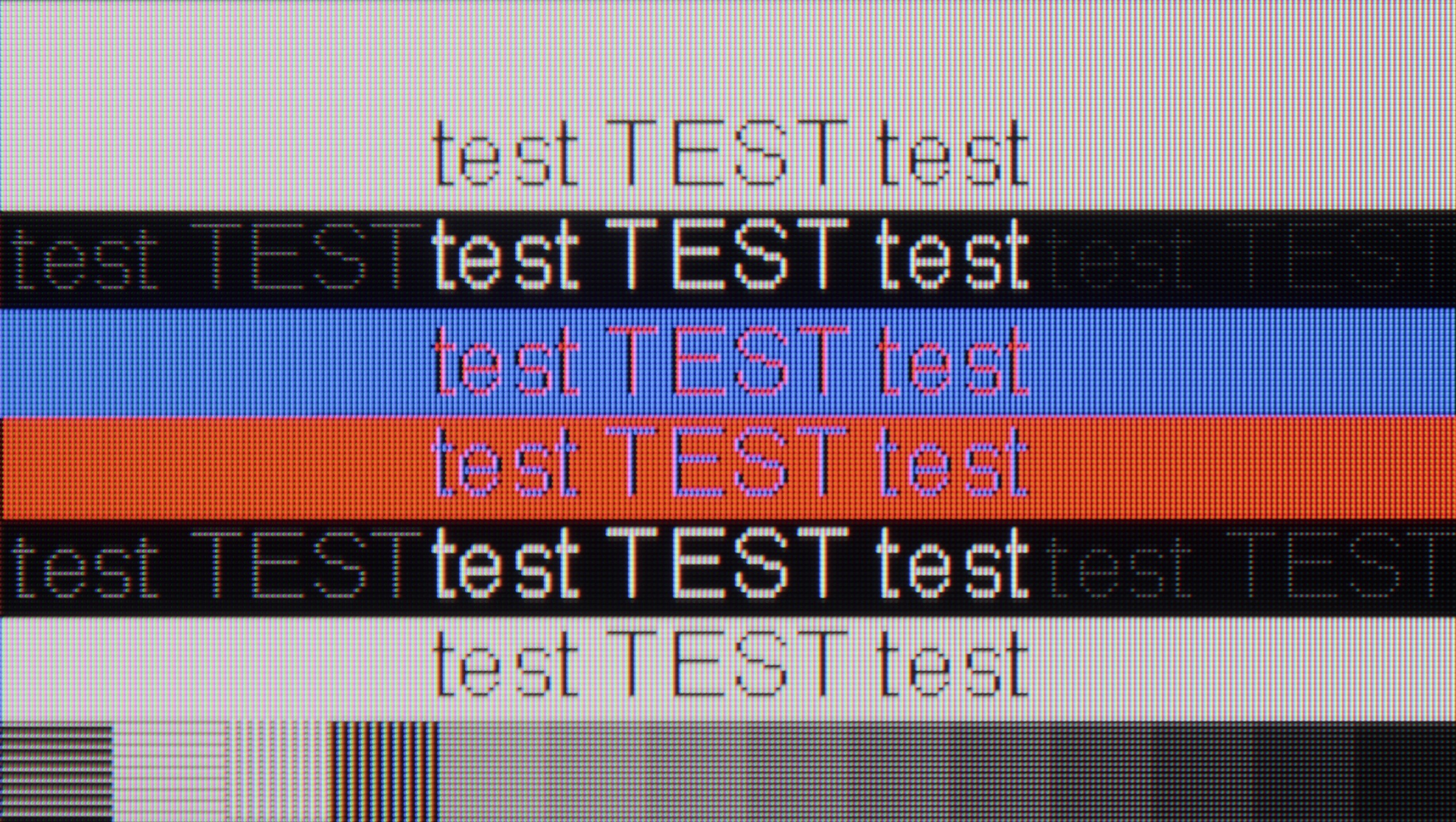
The Sharp GR8 performs quite well as a screen for PC gaming. The 144 Hz refresh rate, low input lag, and support for G-Sync and FreeSync technology provide a setup that guarantees smooth and responsive gameplay. Games look dynamic, and the image remains stable even in the most demanding moments. However, a problem arises when it comes time to work with text. The TV does not support chroma 4:4:4, which means that fonts are blurred and poorly readable. Longer work with documents or browsing websites can simply become tiring for the eyes.
The Sharp GR8 is a great choice for PC gamers, but rather poor for office work. If we plan to use this TV mainly for gaming, we should be satisfied. However, if we think of it as a monitor for daily work, it’s better to look for another solution.
Playing on the QN80F with a connected computer is pure pleasure. The TV works seamlessly with NVIDIA graphics cards (thanks to G-Sync support) and AMD (thanks to FreeSync Premium), and the 144 Hz refresh rate only enhances comfort during dynamic gameplay. Everything works right away, without unnecessary fiddling with settings – exactly as it should.
When it comes to work, it is also very good. The readability of fonts is high, and the texts appear sharp and clear. With very thin horizontal lines, one can notice slight imperfections, but really – you have to look closely. Unless, like us, you sometimes enjoy examining the screen with a magnifying glass… then you might spot something 😉.
Viewing angles
3.2/10
3.1/10
In terms of viewing angles, the Sharp GR8 does not surprise – and it is hard to blame it, considering the use of a VA panel. When watching from a wider angle, the image loses quality, colors become faded, and contrast clearly decreases. Additional coatings that widen viewing angles could improve this aspect, but that is a solution we typically encounter in more expensive LCD TV models. If we plan to watch television mainly straight on, there won't be a major problem. However, in the case of a larger number of viewers sitting at different angles, it is worth being aware of this limitation.
QN80F, like most TVs with VA panels, does not impress in terms of viewing angles. It is enough to lean slightly to the side to notice a significant drop in brightness and lost color saturation. The image loses its "depth" and "vividness," and darker scenes may appear slightly washed out. However, this is a typical characteristic of VA panels, which in return offer significantly better native contrast than IPS panels. In short: something for something. If you are sitting directly in front of the screen – there will be no problem. But when watching together in a larger group, it is worth keeping this in mind.
TV efficiency during daytime
4.5/10
6.6/10

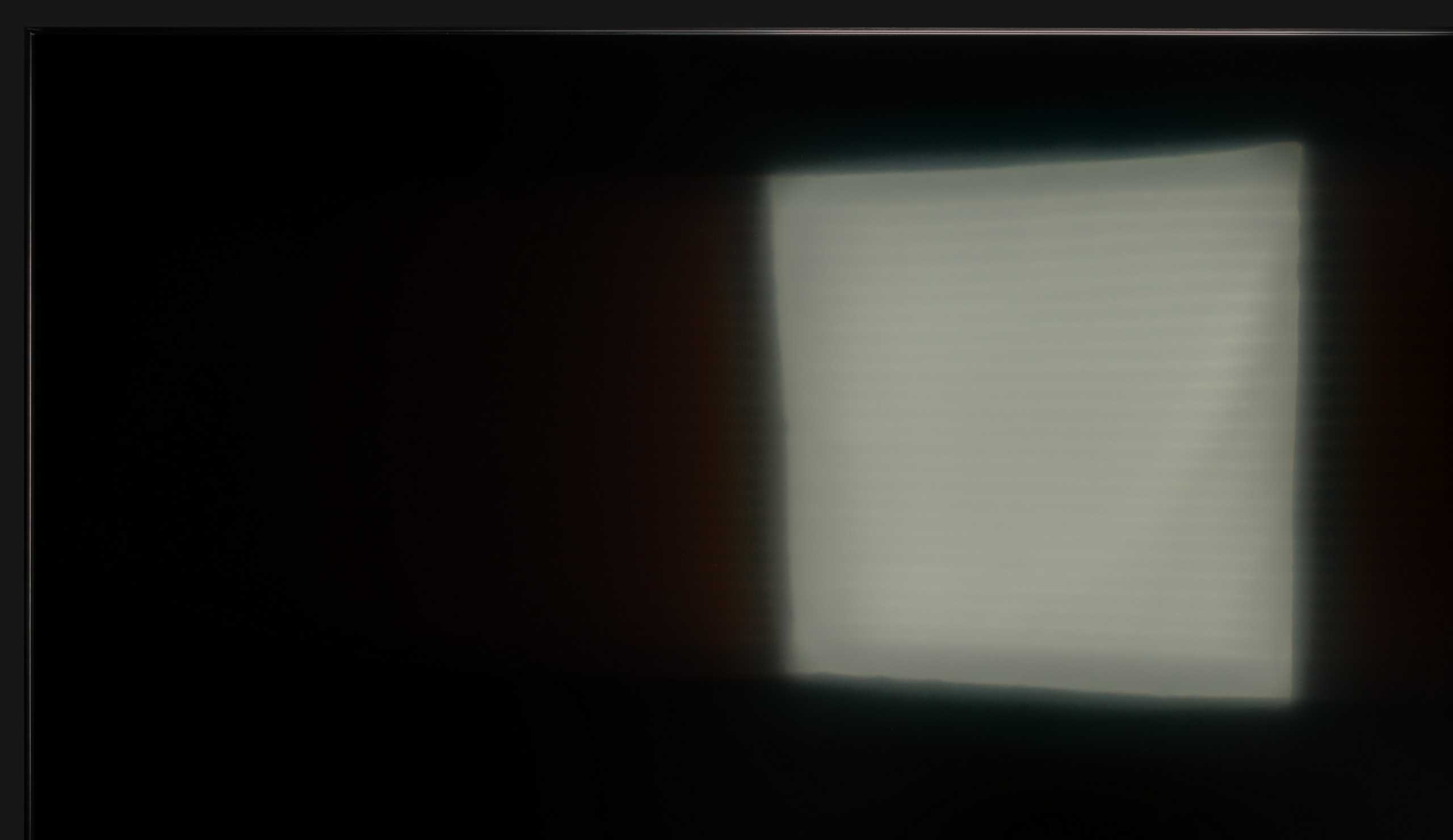


Matrix brightness
Average luminance SDR
SAMSUNG QN80F: 543 cd/m2
Sharp GR8: 329 cd/m2
The Sharp GR8 has a satin finish display that handles reflections moderately. Bright surrounding elements, such as windows or lamps, are quite noticeable on the screen and can be distracting while watching. The brightness level of 330 cd/m² in SDR content is also unimpressive. As a result, the television performs best in rooms with not too much natural light. One could say that the GR8 manages during the day, but it is definitely not equipment designed for heavily sunlit living rooms. If we watch mainly in the evenings or in controlled lighting, this will not be a major issue.
QN80F is really a bright TV. The average brightness in SDR materials is around 550 nits, regardless of the scene, which practically means that you can comfortably watch content even in a well-lit room – and you don’t have to close the curtains every time we turn on a movie. The new satin coating of the panel is also a plus, as it handles reflections much better compared to last year's QN80D. Glare is less bothersome, and the screen maintains readability in various lighting conditions. It's hard to find fault with anything here – the QN80F simply performs great during the day.
Details about the matrix
Subpixel Structure:

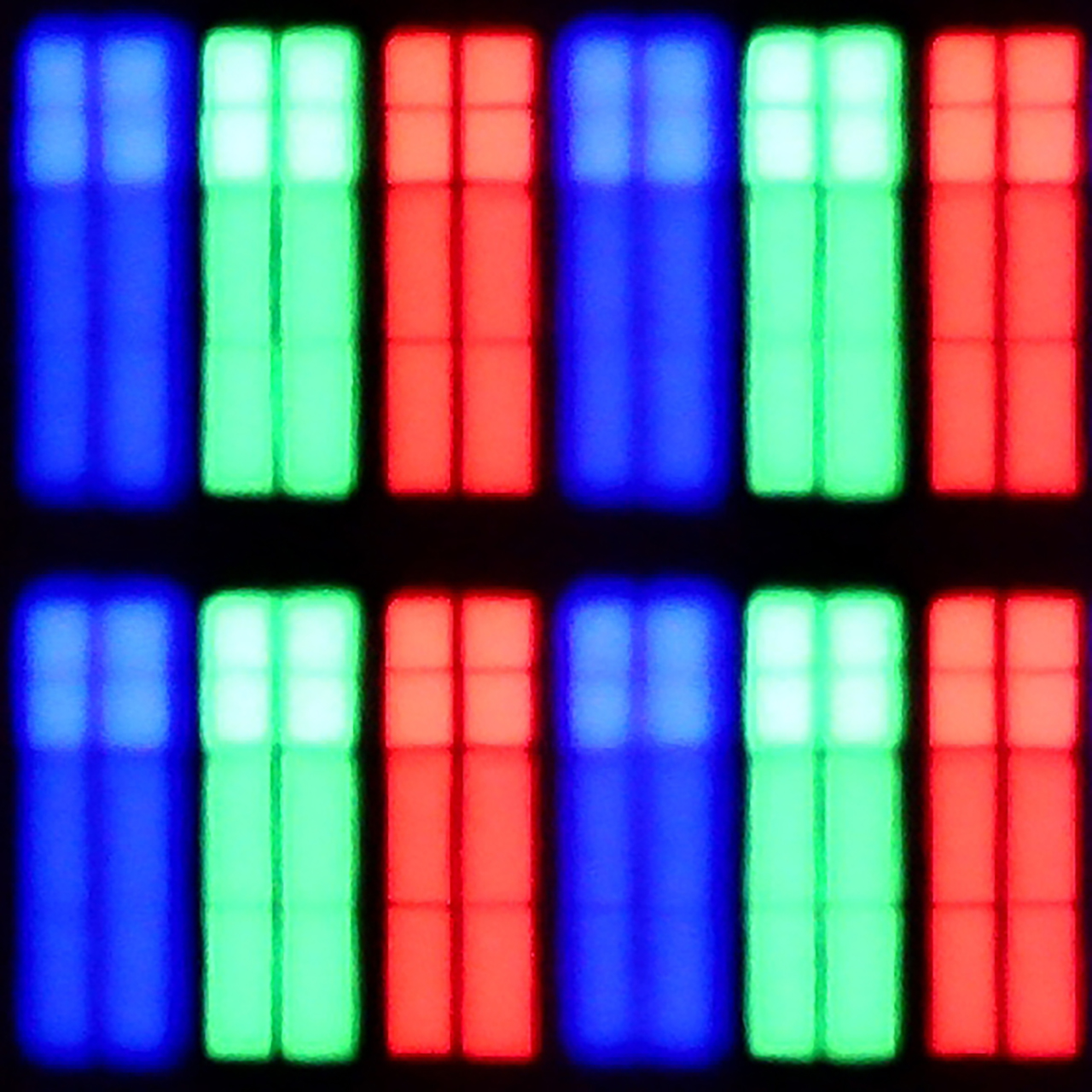
Panel uniformity and thermal imaging:

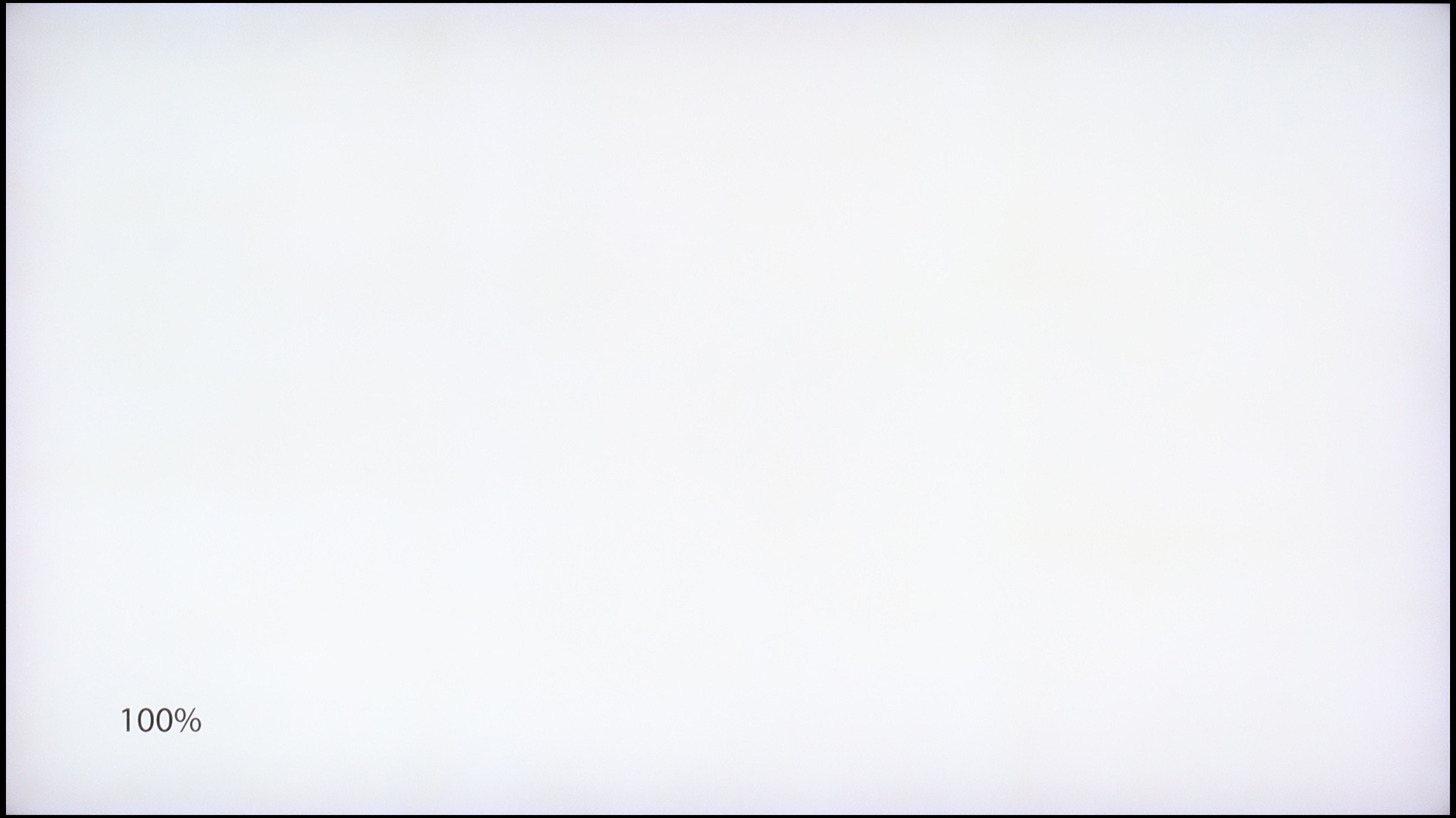
Sharp GR8
SAMSUNG QN80F
TV features
6/10
7.7/10
- HDMI inputs2 x HDMI 2.0, 2 x HDMI 2.1 48Gbps0 x HDMI 2.0, 4 x HDMI 2.1 48Gbps
- Other inputsRCA (Chinch)
- OutputsToslink (Optical audio), eARC (HDMI), ARC (HDMI), Mini-Jack (Headphones)Toslink (Optical audio), eARC (HDMI), ARC (HDMI)
- Network InterfacesWi-Fi 2.4GHz, Wi-Fi 5GHz, Ethernet (LAN) 100MbpsWi-Fi 2.4GHz, Wi-Fi 5GHz, Ethernet (LAN) 100Mbps
- TV receptionDVB-T, DVB-T2, DVB-S, DVB-S2, DVB-CDVB-T, DVB-T2, DVB-S, DVB-S2, DVB-C
Classic features:
- Recording to USB (terrestrial TV)
- Recording programming
- Picture in Picture (PiP)
- RF remote control (no need to aim at the screen)
- Backlit remote control
- Teletext
- Audio only mode
- Bluetooth headphones support
- Simultaneous Bluetooth headphones & TV audio
Smart features:
- AirPlay
- Screen mirroring (Windows Miracast)
- Voice search
- Voice search in native language
- Ability to connect a keyboard and mouse


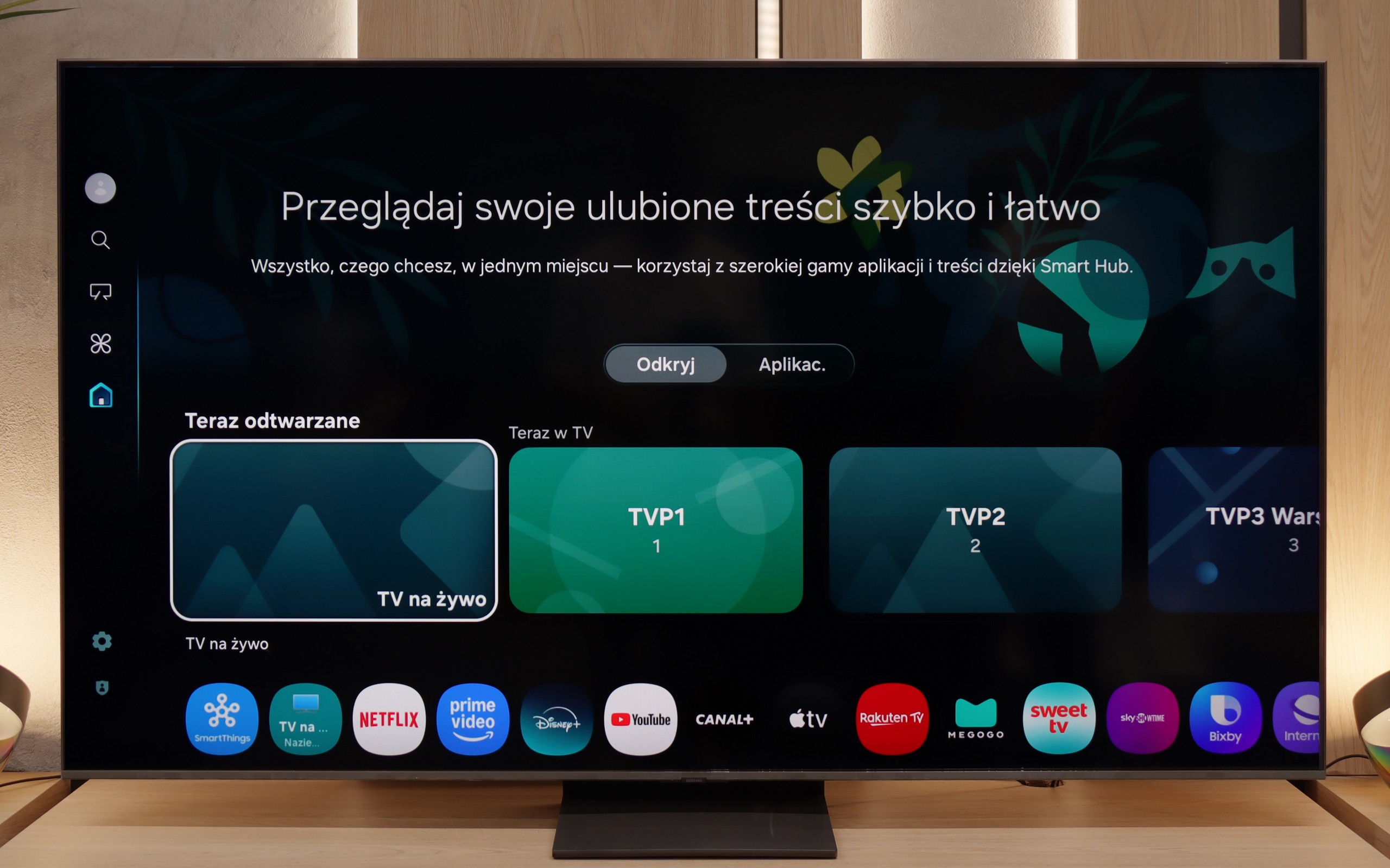
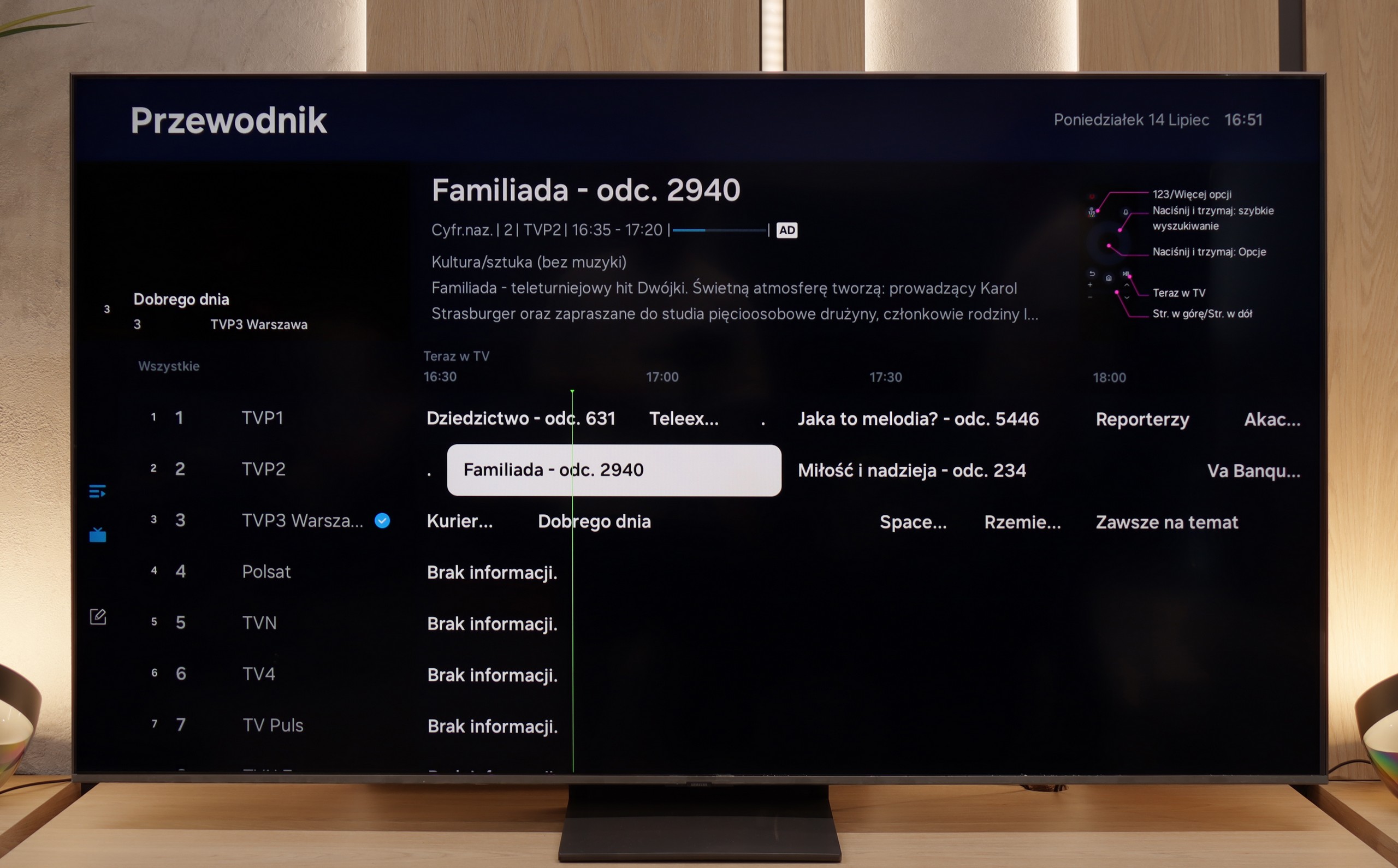
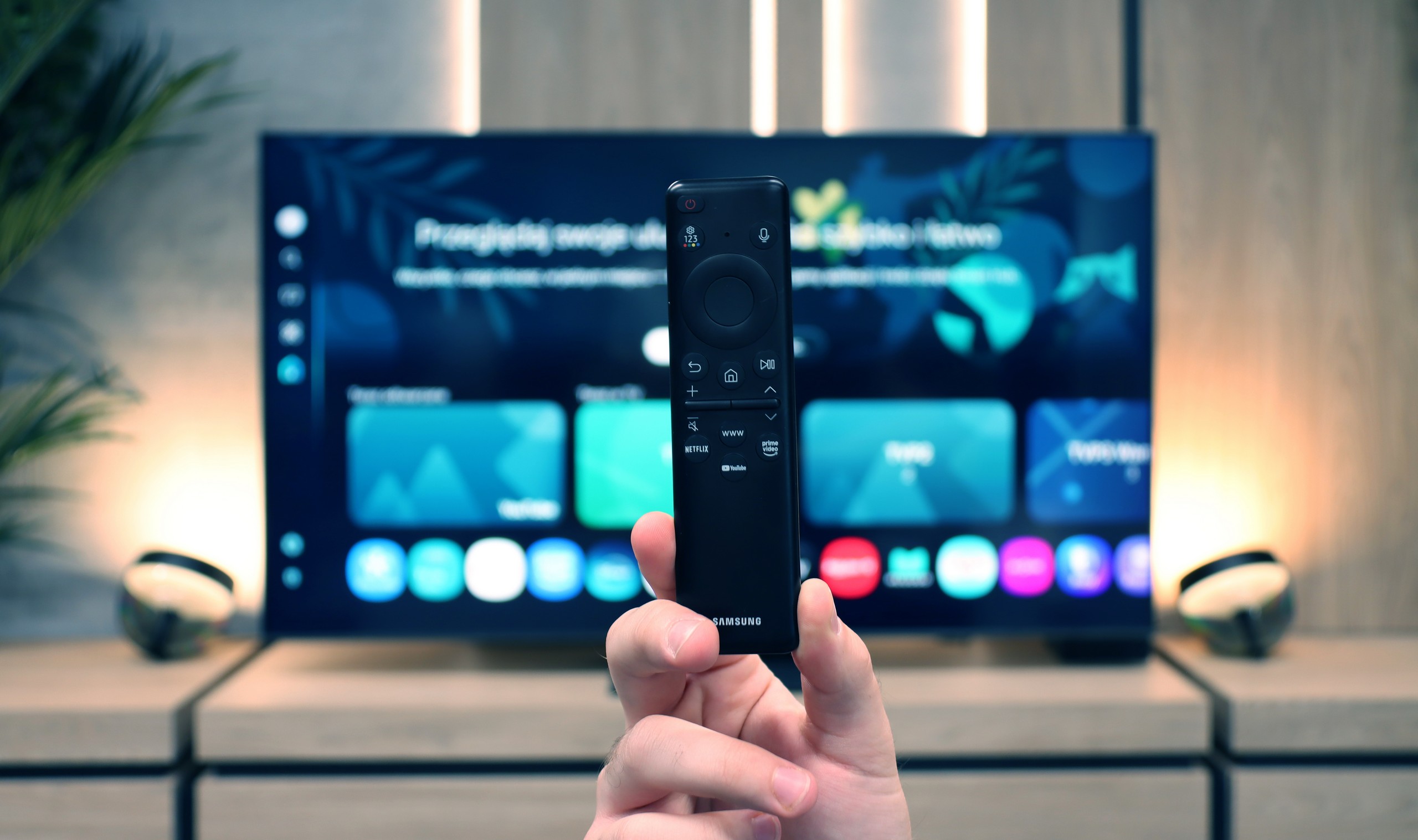
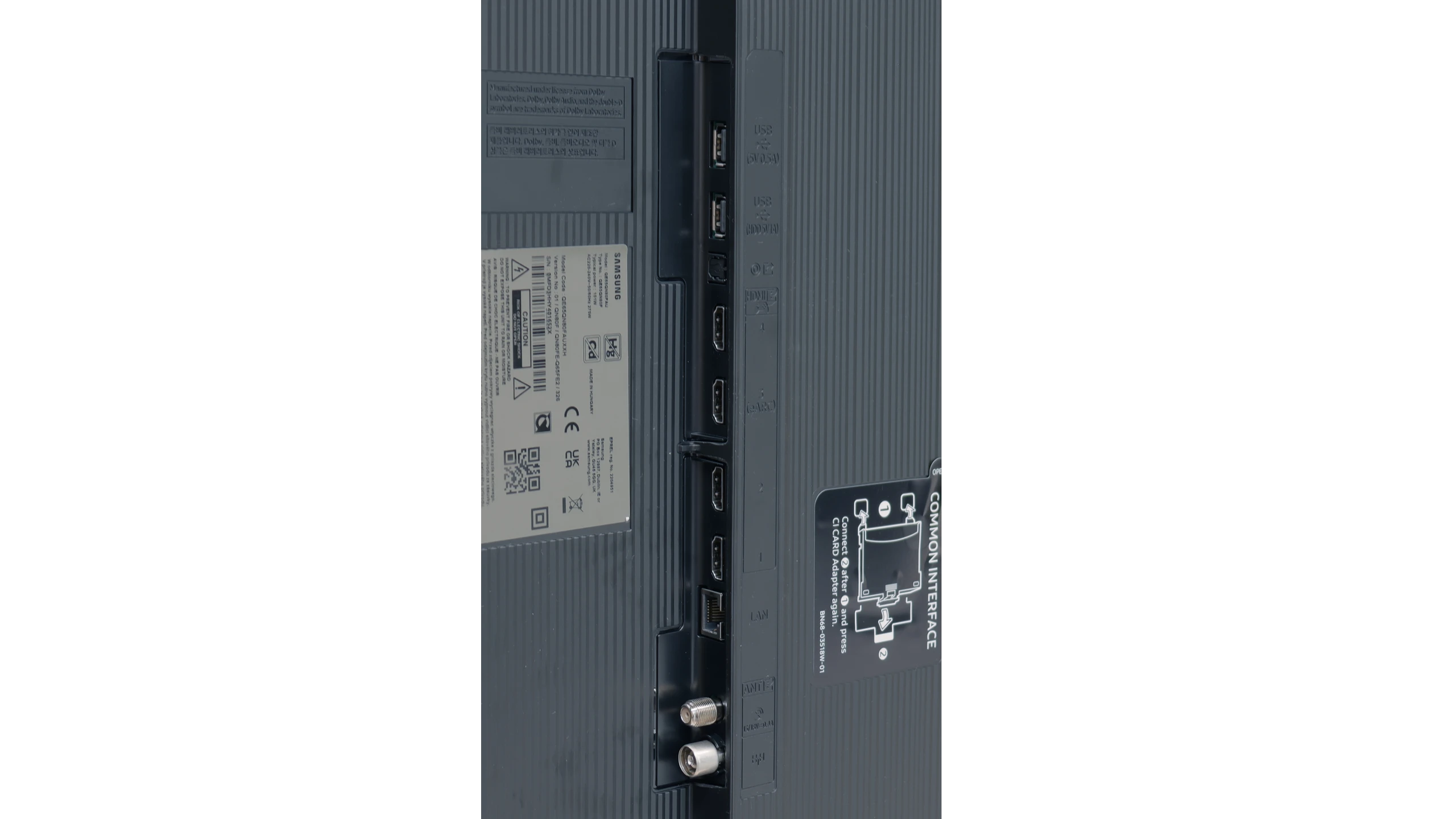
Google TV is definitely the biggest advantage of the Sharp GR8. This system is a true multimedia machine - it features almost all popular streaming applications, such as Netflix, HBO Max, and Disney+. Voice search works in Polish and, importantly, is really responsive. We can tell the TV what we want to watch, and it quickly finds the appropriate content. Moreover, the interface is clear and intuitive, so even those who are not fond of technological novelties can handle it without any problems. In short, Google TV gets the job done.
Unfortunately, when it comes to more classic features, the GR8 is fairly average. There are no options for USB recording or PiP (picture-in-picture) functionality. Moreover, although the TV supports Bluetooth connectivity, iPhone users may feel disappointed as there is no support for AirPlay.
The remote included in the package is simple yet well thought out. It has a solar panel on the front, which allows it to be charged by light, and the additional charging port means we don't have to worry about changing batteries. It is also a plus that the remote does not require pointing at the screen - it works regardless of the direction it is facing.
SmartTV QN80F: Tizen
When it comes to smart features, the QN80F has nothing to be ashamed of. On the contrary – Tizen is one of the richest operating systems in terms of functionality. We have voice search, support for AirPlay, Miracast, and all the major streaming platforms at our fingertips. But Samsung's true advantage reveals itself in the smart home – SmartThings. Here, you can not only synchronize light bulbs and vacuum robots but also integrate devices from other manufacturers, thanks to support for the Matter standard. Suddenly, it turns out that the QN80F can serve as a home command center. There is just one "but" – Tizen is a closed system, so we might not find a few lesser-known apps. However, in practice, it still has everything that 99% of users need.
Classic TV features:
When it comes to classic features, it's just as good – well, almost. The QN80F supports picture-in-picture, a rarely seen but still useful PiP feature. We can easily find EPG, the old good teletext (yes, it works!), and the ability to connect external devices via Bluetooth – whether it's headphones or a soundbar. Unfortunately, there is no option to record to USB from the built-in tuners. That's a minor drawback, especially since the competition at a similar price point is increasingly offering this feature. It may not be a must-have function, but since everything else works so well, it's a pity that it missed that final touch.
Playing files from USB
9.1/10
9/10
Supported photo formats:
Maximum photo resolution:

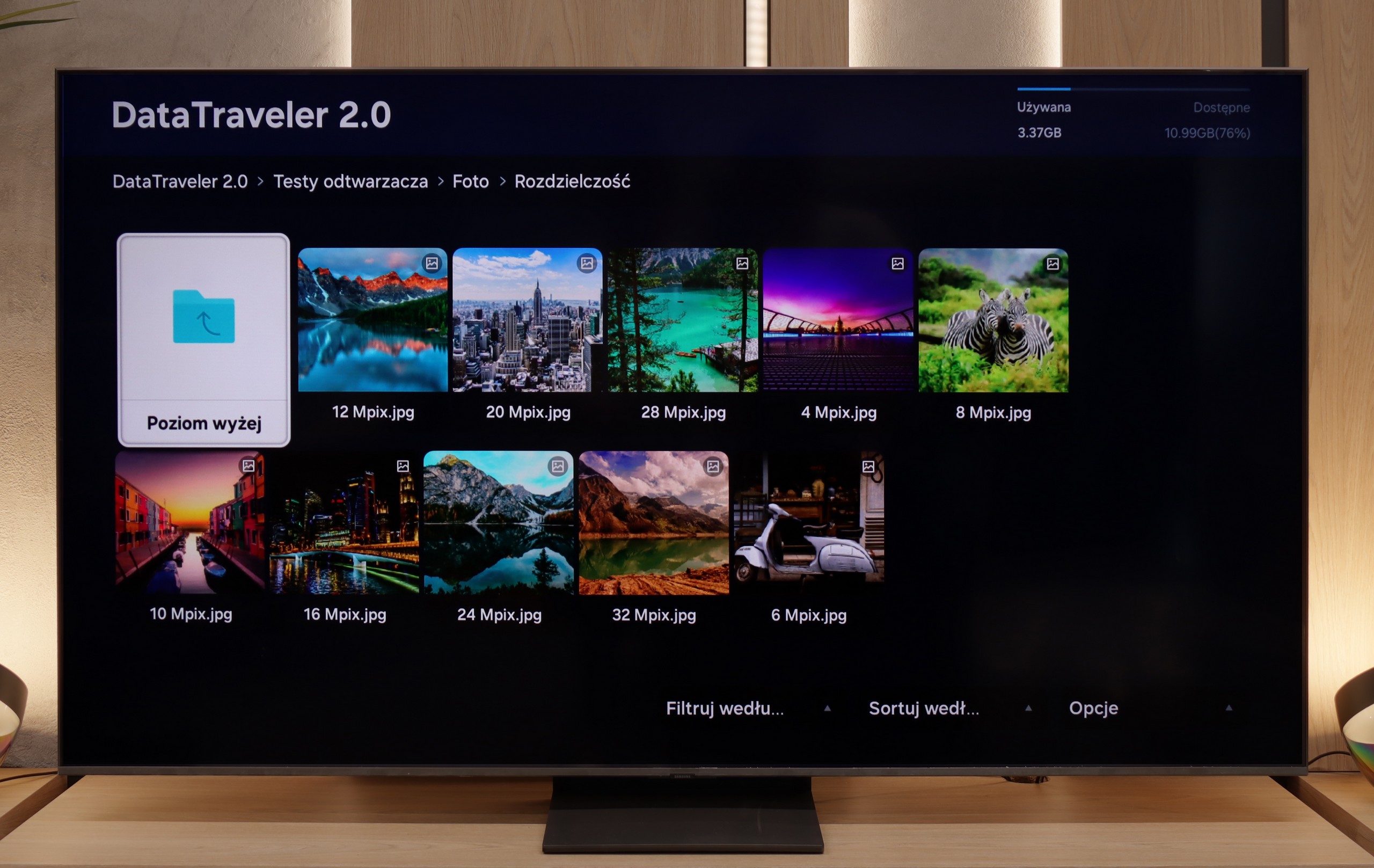
The Sharp GR8 performs really well when playing multimedia files from USB. It supports almost all popular audio and video formats, so we don't have to worry about any file not launching.
However, the built-in player has its limitations – for example, we won't find the option to change the font color in subtitles here. Fortunately, the Google TV system allows us to bypass this problem. You just need to download an alternative multimedia playback app from the Google Play Store, which offers more advanced configuration options.
The built-in media player in the QN80F handles most popular video formats – from classic MP4 to somewhat more demanding containers. It's not a powerhouse like VLC, but it's sufficient for home use. The situation is worse when it comes to photos – here, unfortunately, it's rather modest. The support is mainly limited to the JPG format, but hey, at least that's the most important one 👌. During our tests, there was also a minor issue with subtitles. The QN80F could only handle the simple text format .txt – other, more advanced formats (like .srt or .sub) were unfortunately not recognized.
Apps
9.6/10
8.7/10














































Sound
7/10
6.7/10
- Maximum volume-87dB
- Dolby Digital Plus 7.1
- Dolby True HD 7.1
- Dolby Atmos in Dolby Digital Plus (JOC)
- Dolby Atmos in Dolby True HD
- DTS:X in DTS-HD MA
- DTS-HD Master Audio
Sharp GR8 positively surprises with its sound quality. Although it is equipped with a standard set of speakers, the influence of collaboration with Harman/Kardon is evident. The sound is clear, dialogues are well emphasized, and the overall sound characteristic is pleasant to the ear. It is not on the level of flagship models with advanced audio systems, but for this price segment – it is really good.
Unfortunately, Sharp decided to remove the built-in soundbar that we could see in the previously reviewed model Sharp FQ8. It’s a pity, because this solution significantly improved sound quality and gave the television an advantage over the competition.
For a TV of this class, the QN80F sounds surprisingly good. It supports Dolby Atmos format, which is worth noting, as this is still not a given in many models in this range. Unlike the thinner QN70F, you can even feel a slight bass here – all thanks to the thicker casing, which simply gives more room for the sound to "breathe." For everyday viewing and series, it's more than enough, and with the right settings, you can even consider listening to music without the need to connect external equipment. However – as is often the case with Samsung, there is unfortunately a lack of support for DTS:X format, so if we are using audio devices that support this format, we will first have to connect them to the receiver and only then to the TV.
Acoustic Measurements
No acoustic data
87dBC (Max)
75dBC


